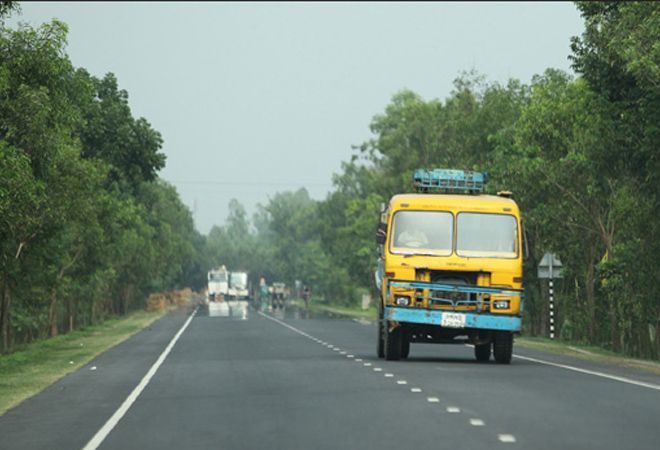-
CENTRES
Progammes & Centres
Location
The challenges that are impeding the BIMSTEC transport connectivity projects need to be addressed to foster seamless connectivity among the member states

The Bay of Bengal Initiative for Multi-Sectoral Technical and Economic Cooperation (BIMSTEC) Master Plan for Transport Connectivity holds immense significance for the member countries in South Asia and Southeast Asia. With a focus on enhancing regional integration, trade, and economic growth, the Master Plan lays out a comprehensive framework to develop and strengthen transport connectivity amongst BIMSTEC member nations.
The fourth meeting of the BIMSTEC Transport Connectivity Working Group (BTCWG), which was held virtually on 20 March 2023, brought together representatives from all BIMSTEC member states, highlighting their collective commitment to advancing transport connectivity in the region. During the meeting, participants engaged in productive discussions regarding the progress in implementing the BIMSTEC Master Plan on Transport Connectivity.
Adopted during the fifth BIMSTEC Summit on 30 March 2022, the Master Plan serves as a blueprint for fostering seamless connectivity amongst member countries. In a testament to the agility and adaptability of BIMSTEC, participants agreed to establish an Expert Group tasked with updating and modifying the list of identified projects. The plan seeks to address infrastructure gaps, streamline regulatory frameworks, and foster cooperation among member states. This proactive approach ensures that the Master Plan remains relevant and responsive to evolving regional dynamics.
By streamlining cross-border trade and enhancing connectivity, this agreement will provide a significant boost to regional economic integration and business.
Of notable importance was the decision to convene the second meeting of the BIMSTEC Working Group, scheduled to take place in the second quarter of this year. This gathering will focus on negotiating the draft text of the Motor Vehicles Agreement—a crucial step toward facilitating the movement of vehicles and goods across borders within the BIMSTEC region. By streamlining cross-border trade and enhancing connectivity, this agreement will provide a significant boost to regional economic integration and business.
Multimodal component
While the development of the Master Plan reflects the strong political commitment of BIMSTEC member states toward strengthening regional cooperation and connectivity, the plan also recognises the need for a multimodal transportation network, including roads, railways, ports, airways, and inland waterways, to maximise the benefits of connectivity links.
Achieving smooth transportation of goods and people throughout the BIMSTEC region can be accomplished by utilising various transportation modes, leading to reduced transportation expenses. Adopting dry ports or Inland Container Depots (ICDs) is an effective means to attain this goal. Additionally, more ambitious initiatives like establishing a multinational, multimodal transit transport corridor, such as the connection between India’s Northeast, Myanmar and the rest of India, can further contribute to seamless connectivity within the region.
Several projects are proposed and conceptualised in the Master Plan with a tentative timeline. However, the discrepancy between the timetable presented in the BIMSTEC Master Plan and the current progress is quite pronounced (Table 1).
Table 1: Planned Flagship Projects for Multimodal and Intermodal Transport Development
| Project Description | BIMSTEC Development logic | Estimated Cost as of 2018 ($ million) | Funding Organisation (tentative) | Estimated Completion Year | Current Status |
|
Second rail-connected ICD in Dhaka, at Dhirasram, in Gazipur, Bangladesh |
For relief of road and (Chattogram) port congestion because the first ICD in Dhaka exceeds capacity |
200 | ADB and PPP | 2020 | The project will begin from 2024 |
|
Establishment of road network from economic zones to adjacent land and seaports through widening of existing roads and national highways in Bangladesh |
Facilitation of multimodal and intermodal connectivity |
To be Specified |
Not yet identified |
To be programmed |
In planning |
| Development of Gelephu Transport Hub in Bhutan |
Diversification of entry or exit points for BIMSTEC trade and transport |
Not yet Specified |
Not yet identified |
2018–2028 | Preparatory work started in 2022 |
| Yangon-Dagon ICD, Myanmar |
Development of multimodal and intermodal facility to handle container traffic |
16 | Private | 2021 | No information available |
|
Yangon Region Dry Port (YwaThaGyi), Myanmar |
Linking Yangon Airport, Yangon-Bago rail line, and eventually Hanthawaddy Airport (as well as Yangon inland waterway ports) |
40 | PPP | 2019 | Dry Port completed in 2019; linking pending |
|
Mandalay Region Dry Port (Myitnge), Myanmar |
Linking Mandalay- Yangon Rail Line |
40 | PPP | 2019 | Dry Port completed in 2019; linking pending |
|
Kaladan Multimodal Transit Transport Project, India- Myanmar |
Potential use of inland water transport as an alternative to a longer road route |
453 | Indian Ministry of External Affairs | 2020 | Sittwe Port operationalised in May 2023; 110 Km Road component incomplete |
|
Establishment of logistics hub and truck or trailer terminal in the Wartayar Industrial Zone (northwestern Yangon) |
Development of multimodal and intermodal facility to handle container traffic |
15–20 | PPP |
To be programmed |
Project cancelled post-February 2021 coup (no reasons cited) |
|
Development of software arrangements for seamless multimodal and intermodal movement (e.g., EDI connectivity between ports and ICDs or land customs stations for online clearance, protocols, use of secure seals) in Myanmar |
Facilitation of multimodal and intermodal connectivity |
5 | Not identified | Not decided | No information available |
Source: Authors’ own based on BIMSTEC Master Plan on Transport Connectivity
Persisting bottlenecks
Several factors, such as financial constraints, regulatory hurdles, lack of coordination, political issues, or technical difficulties have played a significant role in delaying the timelines of the listed projects.
Amongst the several names listed in the planned projects, following years of delays since 2013 due to funding issues, the construction of Gazipur's Dhirasram, the largest inland container depot (ICD) in Bangladesh, is set to commence in 2024. The Bangladesh government has successfully secured financing for the project, estimated to cost around US$ 774.56 million. Kamalapur ICD, the sole ICD with a rail link in Bangladesh, is experiencing congestion both within its premises and on the surrounding roads. To alleviate this issue, the Dhirasram ICD project aims to enhance container transport capacity through rail.
According to an Asian Development Bank report, the strategic location of Dhirasram ICD near Dhaka and along the Dhaka-Chattogram rail corridor provides it with significant advantages to becoming a regional trade logistics hub.
To enhance trade, Bangladesh and India are actively promoting the establishment of international container trains between the two countries.
This project holds fundamental importance in facilitating trade between Bangladesh and India. Road transport dominates bilateral trade, accounting for approximately 70 percent of the total weight. Rail transport has a minimal share, and there is a lack of regular operation of international container freight trains. To enhance trade, Bangladesh and India are actively promoting the establishment of international container trains between the two countries.
Numerous projects in Myanmar encounter considerable obstacles, and the scarcity of available updates regarding their current status is evident. The opening of Sittwe Port in May 2023 creates a vital corridor for efficient goods movement to India's Northeast. However, completing the road section from Paletwa in Myanmar to Zorinpui in India is crucial to fully utilise the Kaladan Project's multimodal element. Unfortunately, obstacles are impeding its progress.
Challenges include the need for coordination among agencies on both sides of the border, rugged terrain, issues with land compensation, and security concerns due to regional insurgency. The COVID-19 pandemic and political turmoil due to the 2021 coup in Myanmar have further disrupted the project's advancement. The Chin State, near which the construction work is ongoing, is currently declared as a no-safe zone, and thus, continuing the work will remain a challenge for an uncertain period.
While the Sittwe port holds significant potential for facilitating trade with Myanmar, particularly in transporting goods, gas, or oil to the Northeastern Region (NER), its effectiveness as a cost-effective regular transportation route to the NER remains to be determined. This uncertainty arises mainly from the projected high costs involved in frequent bulk breaking and trans-shipment activities. Furthermore, the operationalisation of the Paletwa terminal is contingent upon the completion of maintenance dredging along the Kaladan River, connecting Sittwe and Paletwa. Only when the dredging is complete will cargo vessels transport goods to the Sittwe port, limiting the operational scope of the Paletwa terminal.
Investing in capacity-building efforts to strengthen the skills, knowledge, and expertise of individuals and institutions engaged in transportation infrastructure development is equally important.
The way forward
While challenges continue, it is crucial to acknowledge the significance of ongoing initiatives to improve connectivity, reduce transportation expenses, and foster trade within the BIMSTEC region. To this end, enhancing coordination and cooperation among BIMSTEC countries and relevant stakeholders involved in transportation projects is imperative. Moreover, ensuring the availability of adequate financial, technical, and human resources necessary for developing transportation infrastructure and initiatives will be vital.
Investing in capacity-building efforts to strengthen the skills, knowledge, and expertise of individuals and institutions engaged in transportation infrastructure development is equally important. It can be achieved by extending timely training programmes, workshops, and technical assistance to address skill gaps and institutional weaknesses.
It is also necessary to understand the gap between perceptions and realities related to all the conceived multimodal connectivity projects. Timely information sharing, regular dialogues, meetings, and joint monitoring mechanisms should be established to address implementation challenges, share best practices, and foster trust among stakeholders. The BIMSTEC member states can advance their shared goal of creating a well-connected and prosperous region by addressing obstacles, fostering coordination, and adapting to evolving regional dynamics.
Sreeparna Banerjee is a Junior Fellow with the Strategic Studies Programme at the Observer Research Foundation
Anasua Basu Ray Chaudhury is Senior Fellow at the Observer Research Foundation
The views expressed above belong to the author(s). ORF research and analyses now available on Telegram! Click here to access our curated content — blogs, longforms and interviews.

Anasua Basu Ray Chaudhury is Senior Fellow with ORF’s Neighbourhood Initiative. She is the Editor, ORF Bangla. She specialises in regional and sub-regional cooperation in ...
Read More +
Sreeparna Banerjee is an Associate Fellow in the Strategic Studies Programme. Her work focuses on the geopolitical and strategic affairs concerning two Southeast Asian countries, namely ...
Read More +